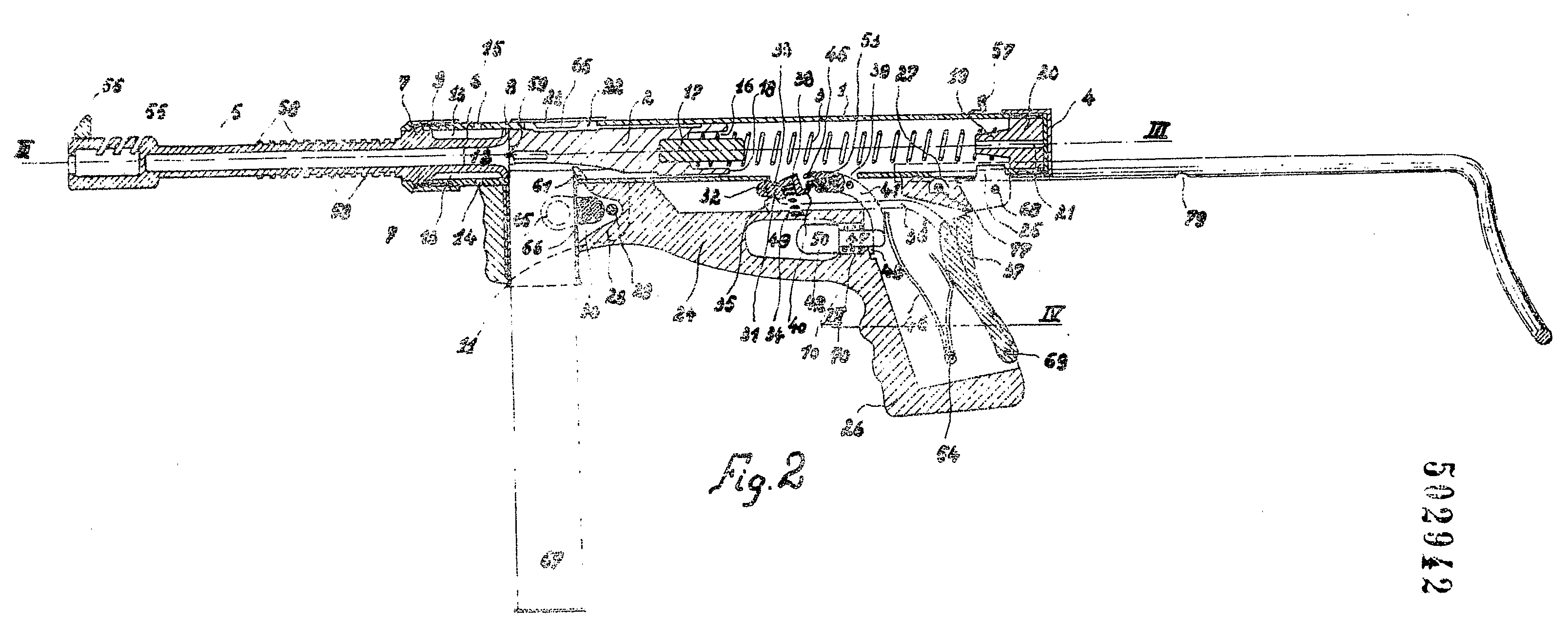Vigneron submachine gun
Pistolet-Mitrailleur Vigneron

In the late 1940s and early 1950s
the Belgian Army became interested in adopting a new service
submachine gun to replace World War II-era surplus such as the Sten,
MP 40, and the former Belgian service SMG, the Mi34 Schmeisser-Bayard.
Among the weapons submitted were designs from Imperia, Grimard,
Repousmetal, and Fabrique Nationale. The submachine gun that was
ultimately adopted, however, was the 9mm Vigneron.
The Vigneron SMG was named for a Belgian officer, Col. Georges
Vigneron, but contrary to popular belief it was not actually designed
by him - Col. Vigneron merely sponsored the design and controlled the
patents. The actual design work was done by a French inventor, Louis
Bonnel de Camillis, on behalf of Paul Renson of the Berger &
Renson metalworking company. The first prototypes were built by de
Camillis at the Berger & Renson factory in Châtelet in 1951. The
gun was subsequently demonstated to the Belgian Army at Bourg-Léopold,
with the tests overseen by de Camillis and Renson. Ten further
prototypes were then ordered by the Army for further trials, some of
which were hand-made by Jean Falla, a Liège gunsmith, and tested at a
quarry in Châtelet under
Gendarmerie supervision.
After these tests, the Belgian Army became heavily invested in the
Vigneron submachine gun and planned to adopt the weapon with
manufacture being handled by Berger & Renson, who were provided
with the necessary machine tools to supply a large military order.
Unfortunately, however, this order never came to fruition due to a
payment dispute that apparently broke out between de Camillis, Col.
Vigneron, and Berger & Renson, which seemed to be irreconcilable.
As a result, de Camillis and Vigneron decided to sever ties with the Châtelet
firm and instead attempted to attract the interest
of a Luxembourgian company, SOLA S.A. This venture also did not pan
out, with SOLA instead investing in a rival design, the RAN by
Repousmetal. Finally Vigneron found an appropriate manufacturer in the
form of Précision Liégeoise S.A., who were able to supply the
100,000-unit order by the Belgian Army. Adoption of the Vigneron
submachine gun therefore went ahead in 1952. Production of the plastic
grips was outsourced to Compagnie de Manufacture Herstal, and bore
their initials, "CMH" in bolded letters.

An early design sketch of the Vigneron submachine gun.
The basic design of the Vigneron submachine gun embodied a new type of
post-war SMG that emerged in Europe in the 1950s, in which the concept
was essentially to improve the Sten gun, whilst maintaining an
efficient production standard and low cost. This philosophy is
self-evident not only in the Vigneron, but in the similar SOLA,
Parinco, Imperia, and RAN submachine guns that appeared around the
same time. To this extent, the Vigneron was mechanically simple,
employing a straight-blowback action housed in a plain tubular
receiver. Some influence from the M3 Grease Gun can also be observed -
namely the retractable wire stock and the hinged dust cover over the
ejection port. The barrel, which was unjacketed, had partial ribbing
and a three-slot compensator on the muzzle. Along with a basic safety
switch, the Vigneron had a push-grip safety in the rear of the pistol
grip. The feed took 32-round MP 40 magazines, which were in great
supply in Europe following World War II.
The Vigneron was initially produced as the M1 model in 1952, but was
quickly supplanted by an improved M2 model in 1953. The M2 model was
merely a detail improvement of the M1, implementing minor changes
including the addition of a protective hood to the front sight, the
reduction of the muzzle compensator slots from three to two, and a
strengthened ejection port cover. Otherwise, however, it was
essentially the same gun.
The Vigneron M2 received its baptism by fire during Belgian
intervention in the Congo War of the 1960s. By all accounts it
performed well and earned a good reputation as a reliable weapon. Many
Vigneron submachine guns in Congolese service ended up being
trafficked around Central Africa and ultimately into the illicit arms
trade, where they were distributed around the world. Some examples
even ended up in Northern Ireland and were used by the IRA. On the
whole, however, the majority of Vigneron SMGs enjoyed a legitimate
service life in the Belgian Army until they were eventually phased out
upon the adoption of the all-purpose FN FNC assault rifle in the
1980s. Limited numbers were also purchased by Portugal and Luxembourg.
Back to database


